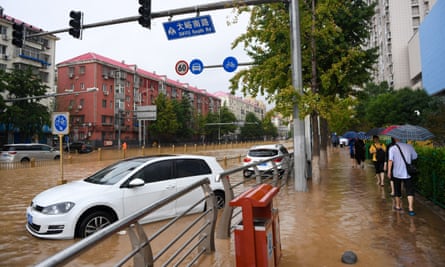Summers in China are often wet, sometimes very wet, but nothing like the drenching that has engulfed Beijing and its neighbouring provinces this week.
As Beijing authorities lifted the flood alert on Wednesday morning, after the city’s heaviest rainfall for 140 years, 21 people across the region were confirmed dead. Dozens more were missing.
According to reports, almost a million people have been evacuated in the region. Rescue and recovery crews searched flooded streets in rubber dinghies for any trapped behind. Hundreds of flights were either delayed or cancelled at the city’s two major airports.
China has been hit hard by extreme weather in recent months, from record-breaking heatwaves to deadly rain. In July, employers across the country were ordered to limit outdoor work due to blistering heat. On Wednesday, the Beijing meteorological service said 744.8mm of rain had fallen since the previous Saturday, shattering a previous record of 609mm, set in 1891.
That is as much as Beijing usually gets in the whole of July. In neighbouring Hebei province, things were even worse. From Saturday to Monday, one local weather station recorded 1,003mm of rain, almost twice the annual average.
According to Chinese meteorologists, the rains were brought by the aftermath of Storm Doksuri, a former super typhoon, as it swept northwards over China after hitting Fujian province, in the south, last week.
As the residual circulation of Doksuri’s rain clouds blew north, a subtropical and continental high pressure system in the atmosphere also blocked their north and eastward passage, leading to a convergence of water vapour that acted like a dam storing the water.
Then, as the clouds above northern China grew pregnant with millions of tonnes of water, they were lifted up by a low-altitude wind, pushing the rain east of the Taihang mountains, to where the worst-hit areas – including Beijing’s Fangshan and Mentougou districts – are located.

Ma Jun, the director of the Institute of Public and Environmental Affairs, a Beijing-based NGO, said that while the typhoon had brought the rain, rising ocean temperatures caused by climate change were also contributing to the extreme weather.
after newsletter promotion
“China has suffered unprecedented extreme heatwaves since last year … this year, there are record-breaking high temperatures in northern China,” Ma told AFP. “These heatwaves are linked to global warming, and this is what most climate scientists around the world tend to agree.”
More is in store for north-east China, forecasters say. Typhoon Khanun, the sixth typhoon of this year, is approaching the country’s eastern coast, after battering Okinawa island, Japan, where it knocked out power to 200,000 homes.
China’s coastal Zhejiang province on Wednesday upgraded its emergency response from level four to level three, with more than 14,000 rescue workers placed on standby.
So far, the province has relocated more than 190,000 people to safer places, suspended 60 sea passenger routes, and temporarily halted 260 water-related projects, China’s Xinhua news agency reported.